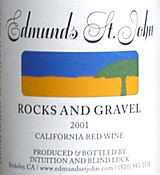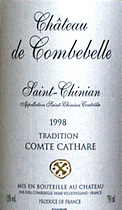|
Tasting the soil
Can you taste the soil of the vineyard when you sip a glass of wine? This is the concept of "gout de terroir" ("the taste of the soil"). Usually abbreviated to just-plain "terroir" (pronounced "tare-wahr," more or less), it's one of those controversial topics that's just about guaranteed to start a debate among wine lovers. At its most simplistic, terroir suggests that the actual flavor of the soil in which the grapes are grown literally communicates itself to the wine. The stony mineral character of Chablis is the result of the chalky soil of its vineyards, the theory goes; the characteristic subtle flavors of Coonawarra Cabernet can be traced to the region's red soil. Most experts take a broader view, defining terroir as the overall effect on wines of the soil, topography, geology, microclimate and even the total hours of sunlight in which the grapes are grown. It is terroir, its advocates argue, that makes it possible to distinguish wines from different parts of the world (or even from neighboring vineyards) on the basis of consistent, identifiable character that relates to the vineyard location. But skeptics note that the wine maker's hand is important too: Decisions about vinification, whether to use wild or natural yeasts, temperature controls, malolactic fermentation, barrel fermentation and aging, and even more intrusive modern tricks such as reverse osmosis and spinning-cone technologies all significantly affect the taste of the finished wine. If terroir was everything, they ask, then wouldn't all Burgundies taste exactly the same? Taken to its extreme, anti-terroirists argue that terroir is purely imaginary, a mythical notion that can't bear scientific analysis. Almost as overly simple is the assertion that Old World (European) wines always show terroir while the New World wines of the Americas and Australasia never do. While there's some limited truth in the generalization that "New World" wines focus on fruit while "Old World" wines reveal earth, it's easy to find examples that disprove the rule, on both sides of the Atlantic. Let's move directly to a stellar example: One of my favorite California wineries, Edmunds St. John, earns my affection because wine maker Steve Edmunds is deeply committed to terroir, and his wines show it.
On his winery Website, For today's tasting I sampled an Edmunds St. John favorite, a blend of Rhone-style varieties aptly labeled "Rocks and Gravel." The back label notes, "our blend of Grenache, Mourvedre and Syrah has always been inspired by the lovely, sunny red wines grown in the South of France, and these days it may be hard to distinguish from the real thing." That sounded like a reasonable challenge, so I tasted it blind against a somewhat similar red blend from the South of France, just to see whether I could tell which was French, which American. It wasn't easy, but I got it right: Both wines showed stylistic similarities, and both spoke of the earth, but the Rocks and Gravel was clearly the better wine. In fairness, it should be noted that it was also the more expensive wine.
Discuss this topic in our online forum:  Edmunds St. John 2001 Rocks and Gravel California Red Wine ($20.99)
Edmunds St. John 2001 Rocks and Gravel California Red Wine ($20.99)
Dark reddish-purple with a ruby glow, this wine offers ripe, almost grapey mixed-berry and plum aromas with a whiff of spice. Juicy plums and fragrant black pepper on the palate, textured and "chewy." Good fruit-acid balance on a solid structure. (Oct. 24, 2003) FOOD MATCH: Couldn't ask for a better match with long-braised beef short ribs. VALUE: Approaching the high end for everyday drinking, but worth saving for a special occasion. WHEN TO DRINK: Doesn't require cellaring, but a few years of maturing could bring additional complexity and flavor interest.
WEB LINK: Here's a link to the winery Website:  Chateau de Combebelle 1998 Saint-Chinian Tradition Comte Cathare ($7.99)
Chateau de Combebelle 1998 Saint-Chinian Tradition Comte Cathare ($7.99)
Dark garnet in color, this wine from the Languedoc shows warm aromas of pruney, raisined fruit, with earthy notes of "tree bark" to add a bit of complexity. Peppery black-fruit flavors are mouth-filling if a bit hot and rough. A blend of Syrah and Grenache, it's a rustic quaff in the old French country table-wine tradition, better with food than on its own. U.S. importer: Langdon-Shiverick Inc., Cleveland. (Oct. 24, 2003) FOOD MATCH: The robust flavors of beef short ribs braised with onions form a hearty foil for this rustic wine. VALUE: Hard to complain at this price, but my resistance would increase if it approached the $10 point. WHEN TO DRINK: I don't see it improving with cellar time.
WEB LINK: Producer Website: Administrivia To subscribe or unsubscribe from The 30 Second Wine Advisor, change your E-mail address, or for any other administrative matters, please use the individualized hotlink found at the end of your E-mail edition. If this is not practical, contact me by E-mail at wine@wineloverspage.com, including the exact E-mail address that you used when you subscribed, so I can find your record. We do not use our E-mail list for any other purpose and will never give or sell your name or E-mail address to anyone. I welcome feedback, suggestions, and ideas for future columns. To contact me, please send E-mail to wine@wineloverspage.com All the wine-tasting reports posted here are consumer-oriented. In order to maintain objectivity and avoid conflicts of interest, I purchase all the wines I rate at my own expense in retail stores and accept no samples, gifts or other gratuities from the wine industry.
Friday, Oct. 31, 2003 |




